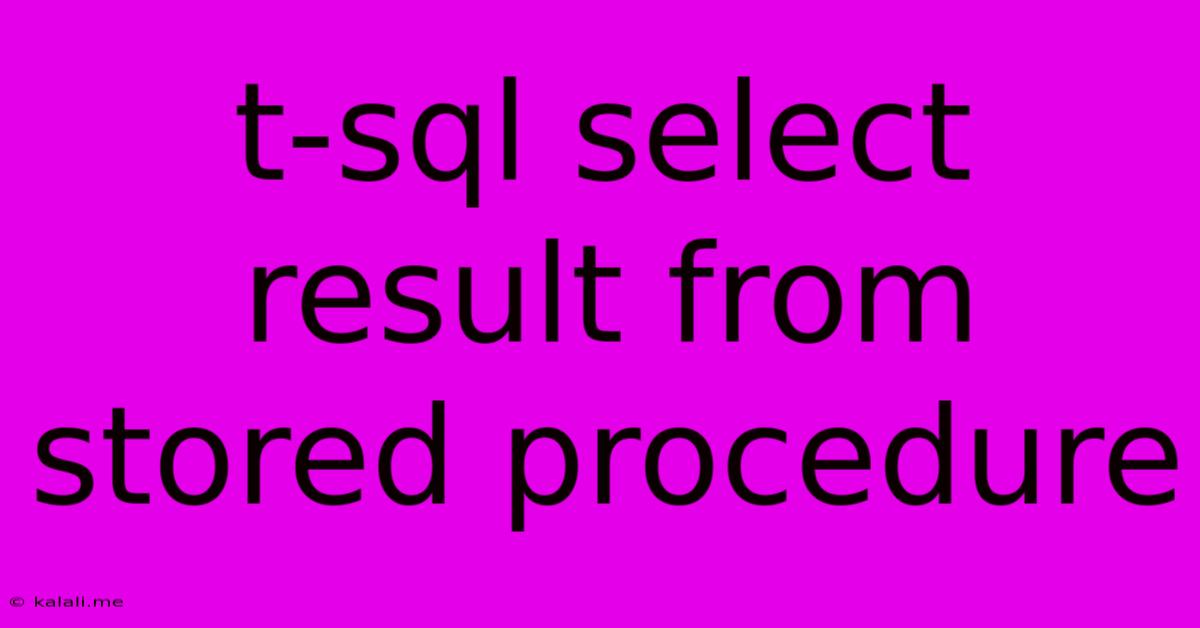T-sql Select Result From Stored Procedure
Kalali
Jun 04, 2025 · 3 min read

Table of Contents
Selecting Results from a T-SQL Stored Procedure
This article explains how to retrieve data from a T-SQL stored procedure, a fundamental task in SQL Server development. We'll cover various methods, best practices, and troubleshooting tips to ensure you can effectively manage and utilize the results of your stored procedures. Understanding how to select results is crucial for building robust and efficient database applications.
Understanding Stored Procedures and Result Sets
A stored procedure is a pre-compiled SQL code block that performs a specific task. They can accept input parameters, process data, and return results, often referred to as a result set. This result set can be a single value, multiple rows of data, or even no data at all. Effectively retrieving this information is key to leveraging their power.
Methods for Selecting Results
There are several ways to retrieve data from a T-SQL stored procedure, depending on how the procedure is designed and how you want to handle the output.
1. Using SELECT within the Stored Procedure
The simplest and often preferred method is to include a SELECT statement within the stored procedure itself. This returns the data directly as the result set.
--Example Stored Procedure returning a result set
CREATE PROCEDURE GetProducts
AS
BEGIN
SELECT ProductID, ProductName, Price
FROM Products;
END;
You can then execute this stored procedure and retrieve the data using a standard SELECT statement:
EXEC GetProducts;
This will display the result set directly in the query results window of SQL Server Management Studio (SSMS).
2. Using OUTPUT Parameters
For procedures that return a single value or a small number of values, using OUTPUT parameters is efficient. The procedure assigns values to these parameters, which are then accessible to the calling code.
-- Example Stored Procedure using OUTPUT parameters
CREATE PROCEDURE GetProductPrice (@ProductID INT, @Price DECIMAL(10,2) OUTPUT)
AS
BEGIN
SELECT @Price = Price
FROM Products
WHERE ProductID = @ProductID;
END;
--Calling the stored procedure and retrieving the output parameter
DECLARE @Price DECIMAL(10,2);
EXEC GetProductPrice @ProductID = 1, @Price = @Price OUTPUT;
SELECT @Price;
This approach is beneficial when you need a specific value, not the entire dataset.
3. Using Table-Valued Parameters and Return Tables (For Complex Data)**
For more complex scenarios involving multiple rows of data, table-valued parameters and return tables offer a structured way to handle the output. Table-valued parameters allow you to pass a table of data into a stored procedure, while return tables allow you to return a result set from a stored procedure.
--Example utilizing a return table
CREATE TYPE ProductList AS TABLE (ProductID INT, ProductName VARCHAR(255));
GO
CREATE PROCEDURE GetProductsByList (@ProductList ProductList READONLY)
RETURNS @Result TABLE (ProductID INT, ProductName VARCHAR(255), Price DECIMAL(10,2))
AS
BEGIN
INSERT INTO @Result
SELECT p.ProductID, p.ProductName, p.Price
FROM Products p
INNER JOIN @ProductList pl ON p.ProductID = pl.ProductID;
RETURN;
END;
-- Calling the stored procedure with a table-valued parameter
DECLARE @ProductList ProductList;
INSERT INTO @ProductList (ProductID) VALUES (1), (3), (5);
SELECT * FROM GetProductsByList (@ProductList);
This approach is cleaner and more efficient for handling large datasets compared to other techniques.
Best Practices
- Clear Naming Conventions: Use descriptive names for stored procedures and parameters to enhance readability and maintainability.
- Error Handling: Implement proper error handling within your stored procedures to manage exceptions gracefully. Consider using
TRY...CATCHblocks. - Modular Design: Break down complex tasks into smaller, more manageable stored procedures for better organization and reusability.
- Parameterization: Always use parameterized queries to prevent SQL injection vulnerabilities.
Troubleshooting
If you're experiencing difficulties retrieving results, check the following:
- Correct Syntax: Ensure your
SELECTstatement, parameter handling, and procedure call are correctly formatted. - Procedure Definition: Verify the stored procedure's definition to confirm it's returning the expected data.
- Data Existence: Make sure the data you're trying to retrieve actually exists in the database.
- Permissions: Confirm that the user executing the stored procedure has the necessary permissions to access the data.
By mastering these techniques, you can effectively manage and utilize the data returned by your T-SQL stored procedures, building more sophisticated and efficient database applications. Remember to choose the method that best suits the complexity of your data and the requirements of your application.
Latest Posts
Latest Posts
-
Freezing Point Of Water In Kelvin Scale
Jun 05, 2025
-
Can You Replace Synthetic Oil With Regular
Jun 05, 2025
-
Gta 5 How To Refresh Your Clothes
Jun 05, 2025
-
Do Vapes Set Off Smoke Alarms
Jun 05, 2025
-
Three Speed Fan Motor Wiring Diagram
Jun 05, 2025
Related Post
Thank you for visiting our website which covers about T-sql Select Result From Stored Procedure . We hope the information provided has been useful to you. Feel free to contact us if you have any questions or need further assistance. See you next time and don't miss to bookmark.